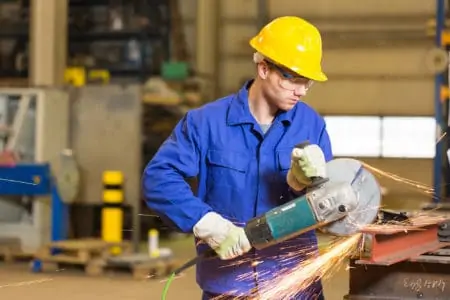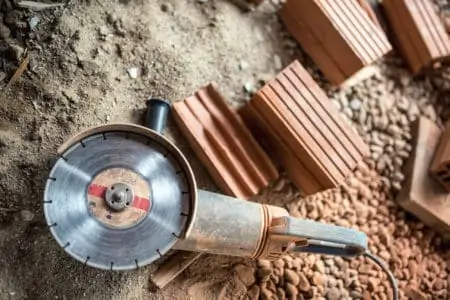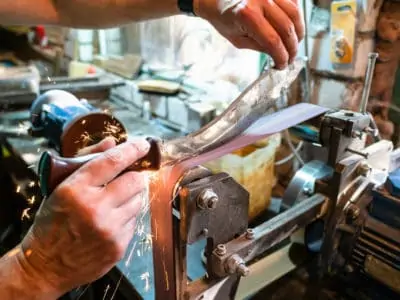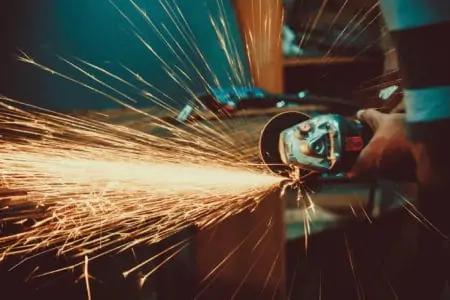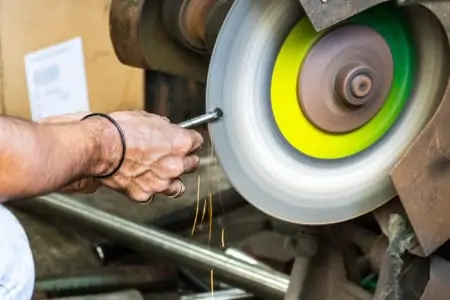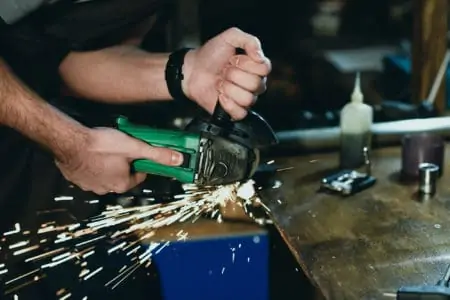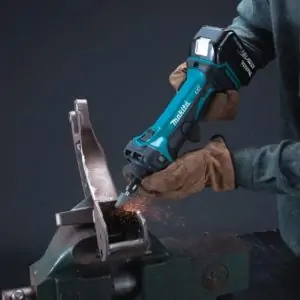According to The Welder, the most common angle grinder injuries occur in 2 groups: young people entering the industry or those with 15 to 20 years worth of experience (1). So it would seem that angle grinder safety is something the experienced and novices have to take seriously.
Let’s take a look at angle grinder safety and plant it front and center in the conversation.
Key Takeaways
- Keep workspace clean and hazard-free: Remove obstacles and flammable materials to avoid trips, falls, and fires caused by sparks.
- Match the disc to the material: Use the correct disc for the material you are working on to prevent accidents and fires due to friction.
- Inspect your grinder for defects: Check for any issues with the grinding wheel, such as cracks or wear, before starting your project to avoid wheel breakage and flying metal shards.
- Wear proper personal protective equipment (PPE): Use safety goggles, hard hat, welding gloves, and appropriate clothing to protect yourself from projectiles, sparks, and other hazards while using an angle grinder.
What Are Most Angle Grinder Injuries From?
Angle grinders spin at between 10,000 and 12,000 revolutions per minute (RPM) and only inches from your fingers. What could possibly go wrong?
There are many ways that injuries occur, but what is the most common?
Keep It Clean
Some of the easiest ways to come to harm are as a result of negligence. Before starting work, make sure that there are no obstacles that might catch you unaware. The last thing you want is a workspace hazard upending you while holding a high-speed cutting disc.
You might get lucky and drop the grinder away from your body, but the possibility of coming to serious harm is real. Do yourself a favor and clean your workspace before you start.
Also, when cutting metal, angle grinders throw off sparks. If you have old sheets or anything flammable in the immediate area, make sure you clear them away so they don’t burst into flames.
The importance of adopting the correct stance and balance is crucial. Don’t overstretch and shift your center of gravity. This is where you lose your footing and fall.
Top Tip
Don’t wear loose-fitting clothing when operating an angle grinder. If something becomes snagged in the cutting wheel, you could suffer a severe injury.
Match the Disc To the Material
Before you start, make sure that the disc you use is suitable for the material. Using the wrong disc could make the task harder and more dangerous. Friction is a real problem with angle grinders, so using a metal cutting disc on wood could cause a fire.
Also, masonry and stone are super-tough, so if you have the wrong blade, it could cause it to shatter, sending shards of deadly metal into the air.
Keep In Mind
The top RPM of the cutting disc should exceed the grinder’s maximum RPM.
Full Speed Ahead
Make sure the grinding wheel is spinning at maximum speed and the grinder has had time to warm up before making contact with the wheel. This is especially true if you are working with harder materials like masonry and stone, where kickbacks can occur.
When the grinder reaches the maximum RPM, make gentle contact with the material, allowing the wheel to cut a groove. Then, apply firm pressure as the tool eats into the object. If you try and start with the wheel in contact with the material, it could jump out of your hand.
A freefalling grinder running at top speed is super-dangerous.
Best Advice
Always use two hands. You can keep a firm grip, and you get better control, especially when cutting through materials like concrete and stone.
Inspect Your Grinder
A good worker knows their tool, and before you start, check the grinder for defects. If the wheel is new, check it over thoroughly for signs of deficiencies. Wheel breakage is common when you use weakened grinding discs, so if the disc is old, maybe you should swap it for a new one.
Never start a project with a worn disc, and don’t chance using a disc if you think it is substandard. The result could be flying strips of razor-sharp metal heading your way.
Top Tip
Tap the side of the cutting disc and listen for a clear bell-like ring. If you hear a dull sound, it means you have a defect like a hairline crack. Discard the wheel for a new one.
Dodging a Bullet
Contact with projectiles is always a possibility when using an angle grinder. Rocks can break apart, sending missiles flying your way. When you make contact with a hard material, anything can happen.
It’s at this point you wish you were wearing your personal protective equipment (PPE). Safety goggles, a hard hat and welding gloves all protect you from projectiles and sharp objects. You can also adjust the guard so it deflects objects away from your face and body.
You could also argue that sparks are a projectile, spraying you in molten particles of metal and stone. Inappropriate clothing could be a flame risk, so wear the correct work gear.
Take Note
Welders use specialty coats and arm guards. Leather is a great material as it protects against sparks and doesn’t combust. Invest in a welding jacket before you start.
Keep Guard
Always use the 180-degree wheel guard. Kickbacks are commonplace, especially as you bite into stubborn material like steel, concrete, masonry, and rock. The guard protects your fingers should the dreaded kickback occur.
As we also said, to reduce kickback, grasp the grinder with both hands. It may not stop it altogether, but it is a lot harder to drop a grinder when you have a firm grip.
Best Advice
While it is the best practice to let the grinder reach the maximum speed, it is also advisable to wait until it comes to a complete stop when you finish grinding.
Cables and Cords
Unless you have a cordless angle grinder, you need to be aware of your power cables and extension cords. Entanglement is all too easy, causing you to trip, slip, or yank the angle grinder from your hands.
This safety point links to our first one: keeping an orderly workspace is vital, including knowing where your power cords are.
Top Tip
If you have excess cable, coil it away from your workspace, so you don’t become entangled. You can also buy rubber floor mats that have ducting to run the lead, so you don’t trip.
If You Can’t Stand the Heat
Angle grinders generate heat, especially when you are working with wood. Wood and friction equal fire. It’s a good idea to work in short bursts to minimize the fire risk. Metal grinding creates sparks, so keeping your work area free of dust and flammable materials reduces the instances of flames.
Also, you should make sure the grinding wheel has cooled before placing it down. These discs get incredibly hot and can start a fire.
Try This
Keep a bucket of cold water next to your workstation to dip the material regularly. It stops heat build-up, which minimizes fire risks. It also acts as a tool to put out the flames in an emergency.
It’s Shocking
Inspect your angle grinder before you start work. Look for splits in the power cord or melted cable sheathing that might indicate an electrical issue. Check the plug is attached correctly, and if you are using water to dip your projects, ensure moisture is kept away from the power tool.
If water gets inside the grinder, it could spell the end of your machine and the end of you. You can minimize the risk by wearing rubber gloves.
Take Note
Rubber-soled work boots offer a degree of protection against electric shocks.
Loud and Proud
Angle grinders are super-noisy, so wearing ear defenders or earplugs is essential if you want to avoid damage to your hearing. Most grinding tools operate at volumes higher than 100 decibels, which is ear-splittingly loud.
Ear defenders keep you from going deaf, but it is also advisable to limit the amount of time you use the grinder. Imagine the torture if you used it all day without respite.
Also, the noise factor increases with the different types of material. Working with wood is a lot quieter than steel or stone. Plus, if you are working at home, in the garage, your neighbors will get annoyed if all they hear is the whine of an angle grinder for hours at a time.
Be Aware
The harder you press down on the grinder, the louder it gets. Try gentle pressure and always keep the grinder at arm’s length.
Angle Grinder Health Risks
Okay, so we’ve kept you safe up to this point, but there are some long-term health effects of using an angle grinder. The secret to safety is protective equipment. Goggles, hats, facemask, gloves, and proper work clothes keep you from harm.
So, what are the risks?
Extreme Noise
Angle grinders are loud, seriously loud! Most operate between 95 and 100 decibels, which is the equivalent of a revving motorcycle. Imaging that day in and day out, and you can understand why grinders can damage your hearing.
With that in mind, the correct protective equipment to use is ear defenders. Check the rating to ensure they can muffle 100 decibels.
Fumes and Dust
Fumes and dust are a necessary evil when it comes to using an angle grinder. The secret is to protect against their effects. Imagine breathing in all that dust and what it can do to your lungs.
Concrete and cement contain calcium oxide, which is corrosive to the skin, as well as chromium and silica, which causes extreme allergic reactions. Goggles and a face mask keep you safe but make sure the face mask is the N95 variety.
These medical-grade masks filter out 95 percent of all hazardous particles and considering how fine grinding dust is, it’s crucial to get the best protection.
Extreme Vibrations
The Beach Boys may have sung about Good Vibrations, but they are not the sort you get with your angle grinder. Hands and wrists suffer badly with prolonged use, leading to musculoskeletal disorders (MSD), which occur because of repetitive motion and awkward work positions, according to the Occupational Safety and Health Administration.
The best way to limit the far-reaching consequences of MSD is to limit the amount of time you use your angle grinder.
Sparks and Projectiles
Because of the way you use an angle grinder, it is commonplace for sparks to fly in the direction of your face. This could lead to blindness or skin damage, not to mention the fire risk.
The best way to avoid this is to invest in a welder’s helmet. They are designed to deflect the brightness and heat from the sparks, keeping you safe.
Angle Grinder Safety Checklist
Knowing the best practices is vital to any safe working environment. Here’s a handy checklist.
Pre-Operation
- Understand the task (instructions, specifications, drawings).
- The correct disc is installed.
- Workpiece is securely clamped.
- Wheel guard is installed and set up correctly.
- Identify the power switch.
Operation
- Check the disc runs true and doesn’t wobble.
- Keep your hands away from the disc.
- Disconnect the power when changing discs.
- Make sure the guard is in place.
- Isolate the power source when cleaning and maintaining.
Post-Operation
- Switch off the grinder before removing waste from the bench.
- Inspect the disc for condition before storing it away.
Angle Grinder Maintenance
Safety starts and stops with good tool maintenance. How can you keep safe if the angle grinder you have is unsafe or possibly deadly?
- Check there are no breaks or cracks in the body of the angle grinder.
- Check all the screws to see if they are secure.
- Are the brush caps in place and intact.
- No splits and breaks in the cable sheathing.
- No exposed wires.
- The cord is safely coiled, and the plug is connected properly.
- All plugs (including extensions) are free from cracks and damage.
- A residual current device (RCD) or safety switch is always used.
What PPE Should You Wear When Using an Angle Grinder?
The best way to keep yourself safe is to protect against injuries. Protective equipment keeps us all safe. But what kit should you get when using an angle grinder?
- Wide vision safety goggles or safety glasses.
- A welding helmet.
- An N95 face mask.
- Ear defenders or earplugs.
- Safety work boots with reinforced toe caps.
- Welding shirt or close-fitting clothing or overalls and an apron.
- Tight-fitting gloves that allow good grip and control.
Safety Is Not a Luxury, It’s a Necessity
If you don’t take your safety seriously, you will fall foul of a mishap. The fact that almost all injuries are avoidable tells its own story. As we said at the start, according to The Welder magazine, most accidents occur in the younger, entry-level groups and those with 20 years of experience. Why is this?
It smacks of two things: inexperience and complacency. And there is little excuse for both. Not knowing how to do something is no defense, and neither is knowing and not caring.
